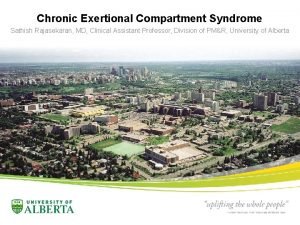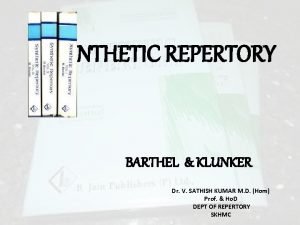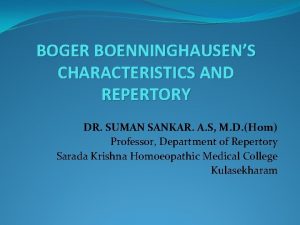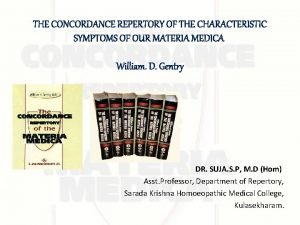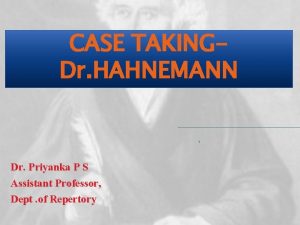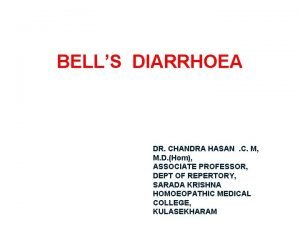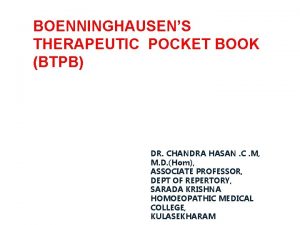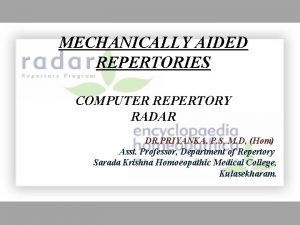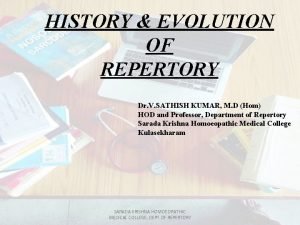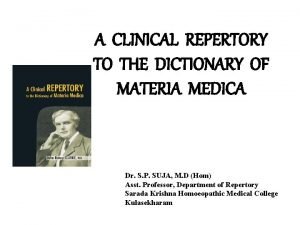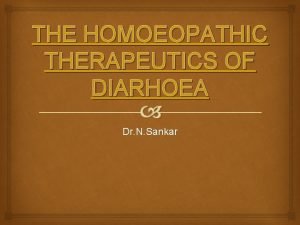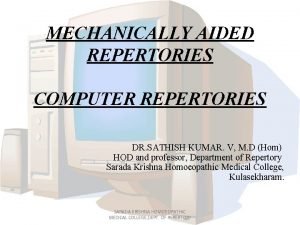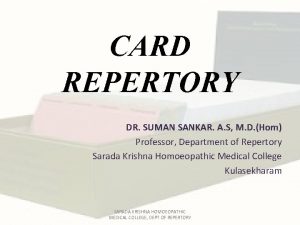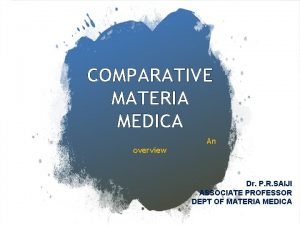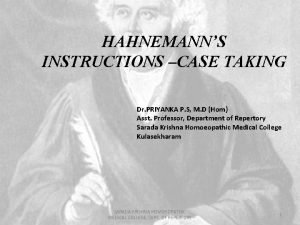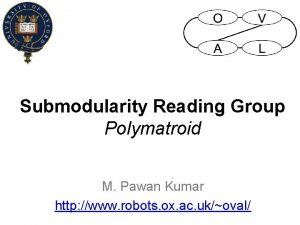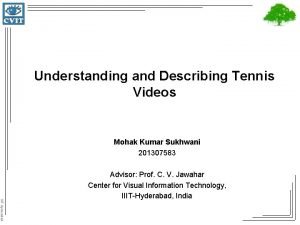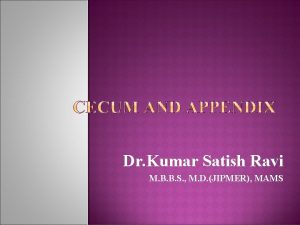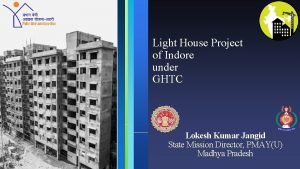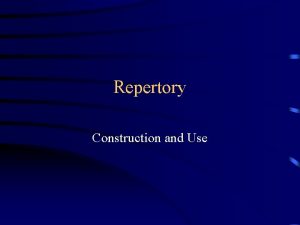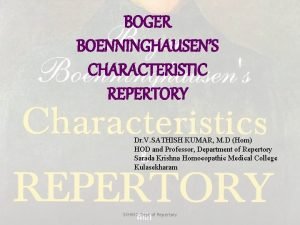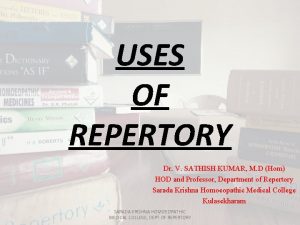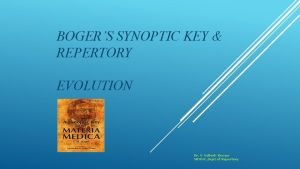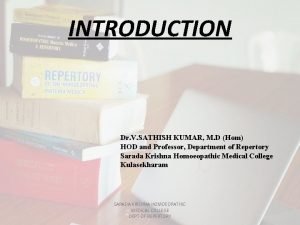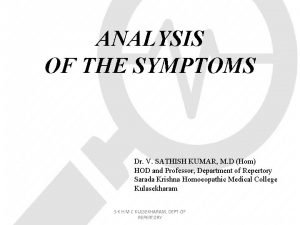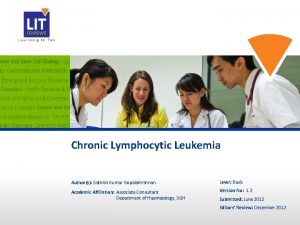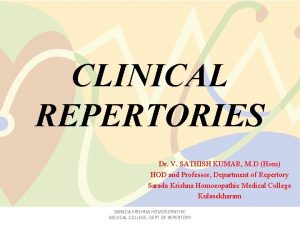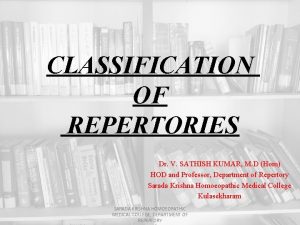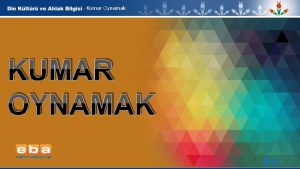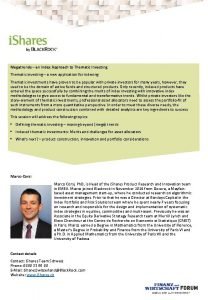THEMATIC REPERTORY Dr V SATHISH KUMAR M D
























- Slides: 24

THEMATIC REPERTORY Dr. V. SATHISH KUMAR, M. D (Hom) HOD and Professor, Department of Repertory Sarada Krishna Homoeopathic Medical College Kulasekharam

� � � Thematic (adj. ) of the basic word Theme, which means a subject being discussed or a melody which is repeated in a work. This book is named so, as it contains words, or words and its synonyms, or words with its antonyms which are repeatedly told by the patient with a special delight or emphasis. Hahnemann used to consider the mental symptoms as the most valuable when choosing a medicine.

� AUTHOR: Dr. Jose Antonio Mirilli, MD is a Brazilian Homoeopath. CONTRIBUTIONS • Repertório Temático (English-Portuguese), 1993 -1996. • Matéria Médica Temática (English), 1994 -1996. • Dicionário Temático (English), 1994. • Matéria Médica Temática (Portuguese) - Robe Publisher, 1996.

EMERGENCE OF THEMATIC REPERTORY � � � The symptoms of a Pure Materia Medica seemed to the author totally unintelligent. Later he understood the experimental nature of homoeopathical symptoms and started thinking about how hard it was to study the symptoms that are spread along the several volumes of Materia Medica. He wondered if there was an easier way of organizing the symptoms for the homeopathists. When he discovered Bernal’s thematic work he foresaw the possibility of organizing the homeopathic symptoms of the Pure Materia Medica by themes. This work is an aid to understand the mental pictures of many of the polychrests using keywords and themes.

SOURCES � The following Materia Medica's were used for quotations: • Materia Medica Pura and Chronic Diseases of Hahnemann. • T. F. Allen’s Encyclopedia, and The supplementary symptoms of the tenth volume. • H. C. Allen’s Materia Medica of the Nosodes. • Hering Guiding symptoms. • Jeremy Sherr’s Dynamic Provings, vol. 1.

BOOK PROPER � REPERTORY PROPER 1 st published in the year 1994 & revised edition came in 1998.

TABLE OF CONTENTS: • Foreword by VII-XIV • Introduction by the Author XV • Thematic Repertory Index- Alphabetical List of Themes XIX • Analogical Index of Themes and Synonyms XXIII • Index of Remedies of the Alphabetical list of Pure Materia XXXVII • Thematic Repertory- Symptoms of Repertory and Pure Materia Medica ordered by Themes 1814 • The Study of Words 815 -818 • Pure Materia Medica Word Index 819 -874 • Alphabetic List of Pure Materia Medica Symptoms 875 -1086 • Remedies and Abbreviations 1087 -1110 • Abbreviations and Remedies 1111 -1134 • The Author's identification and frequency list 1135 -1137

FOREWORD AND INTRODUCTION � � FOREWORD is given by seven authors of this century who have appreciated his work as it makes the study of mind symptoms of Pure Materia medica easy. INTRODUCTION (includes the STUDY OF WORDS, in revised edition) the author has mentioned as how he got the idea of writing this book. Initially he attempted on reading the homoeopathic symptoms and did an analogical research of the key words of the symptoms in English and later used those words to create themes. He has spent 5 years in researching and organizing the Pure Materia Medica symptoms.

INTRODUCTION BY AUTHOR � The main aim of the repertory is to classify the homoeopathic symptoms so they could be used by the homoeopaths for fast medical advice, but there are four limitations, as mentioned below: • The symptoms being served and classified in alphabetical order have no connections and loose their dynamic expressions. • The symptoms come from several sources, but the similar symptoms are at different places and are not related. • The symptoms taken from Pure Materia Medica are not totally represented in rubric form. • There is a great difference in vocabulary between the Repertory and Materia medica. In Repertory the symptoms are organized not by description but according to the author’s own perception and awareness of reality.

� It is not enough to add new medicines in the rubrics but we have to review its concepts and create new rubrics. For example – classical symptoms such as “anxiety of conscience” are explained now-a-days as the “guilt” according to psychoanalytic concept. For replacing old terminologies with the present, various dictionaries have been used, e. g. “The American Heritage”, “Webster’s old unabridged edition”, “Aurelio Portuguese dictionary”, “Houaiss” English Portuguese dictionary and the CD-ROM “Microsoft Bookshelf”.

� In compiling the work, the author has attempted to satisfy these points by putting all the related rubrics of the symptoms under one theme and giving the medicines with original source in the proving. � In Barthel's Repertory, e. g. , symptoms of Pulsatilla are related to the forsaken theme: - Delusions; alone, she is always, - Delusions; alone world, she is a. in the, Delusions; deserted, forsaken, is - Delusions; neglected, of being, - Fear; neglected of being, - Forsaken; isolation, sensation of. In Hahnemann's Materia Medica, the complete symptom is given (Ha, 1143): "Her head is so quiet and all about her is so empty as if she were alone in the house and in the world; she doesn’t wish to talk to any one, just as if all around her were no concern of her and she belonged to nobody. "

� � In Pure Materia Medica, we can observe that certain words give significance to symptoms, and these are theme words. We can make a group of theme words and create thematic groups. It was necessary to deeply scrutinize the meaning of most important words present in symptoms in the English language, and to search for their analogues, and look for resemblances. A dictionary with more than 4, 000 words in English language was created, with main words of PMM mental symptoms, and their synonyms. The meanings of the Words are exemplified by the symptoms in which they occur rather than from the dictionary. For example - the word hypochondria, in the classical texts, can be, in some symptoms, similar to melancholia or other symptoms fear of illness, or illusion of illness - like in the contemporary dictionary meaning. These studies resulted in the compilation of the Thematic Dictionary.

� The author used the Thematic Dictionary as a side repertory, extending the entry menu of traditional Repertories. � The nomenclature of the bibliographical references given at the end of each medicine, refer as: • Ha- with numbering below 200 is for the Chronic Diseases and above 200 for Hahnemann’s Materia Medica Pura. • Al- for the T. F. Allen’s Encyclopedia, Al-S for the supplementary symptoms of the tenth volume. • Al-N- for the symptoms of the H. C. Allen’s Materia Medica of the Nosodes. • He- for the symptoms taken from Hering’s Guiding Symptoms. • Sh- for the symptoms taken from Jeremy Sherr’s Dynamic Provings, vol. 1

� The symptoms from repertory were organized in approximately 1700 mental themes. � The great themes, about 300, were created based on the main issues repeatedly found in the symptoms and 1400 short themes or word themes from important and meaningful words selected in the Complete. Repertory and proving symptoms.

� Obviously the short themes would be connected to the great themes through cross indications immediately after theme entry. � The short word theme “cleaning” would be linked to the great theme “dirty” that would encompass not only the word clean but all symptoms associated to the idea of cleanliness or dirtiness. � Be aware that cleanliness is a short theme included in the great theme dirtiness. If cleanliness is the first idea you have, even if you don’t consider dirtiness, you will be able to come to the great theme “dirtiness” through the cross indications. � The same is true for the short theme “disorganization” and the great theme “organized”. Symptoms containing the word disorganization would be found in a specific short theme which would have a cross relation with the great theme organized.

� � There are 300 great themes and 1400 short word themes. From the short themes or word themes you get to the great theme in common. Instead of 300 original great themes entries, we now have 1700 entries containing themes that are all connected by cross relations to the great themes. Another benefit derived from presenting together the most meaningful words of the Repertory symptoms and pure materia medica, is the understanding we can have about 1700 important words used in the Repertory and pure materia medica by comparing their words. This would be a characteristic Homeopathic dictionary. The general idea is to make it easier for the user to get to the symptoms, by entering the Repertory through a specific word (short theme or word theme) or a general idea (great theme).

� INDEX OF THEMES AND PAGE NUMBER Abroad 1 Accidents 1 Accused 5 Alive 5 Ambition 6 Anger 8 Animal 27 Antagonism 41 Anticipation 48 Approached 52 Attacked 54 Avarice 58 Betrayed 59 Bite 62 Blood 64 Bother 66 Bothered 67 Bright 72 Brother 76 Burn 76 Busy 77 Camouflage 79 Capricious 80 Cares 82 Caught 84 Censorious 84 Censured 89 Child 92 Clairvoyance 98 Clothes 99 Company 102 Compassionate 108 Conducted 112 Confidence 112 Conscience 119 Conscientious 138 Consolation 141 Constriction 141 Contemptuous 142 Contradiction 148 Contrary 151 Corpse 152 Cowardice 153 Crawling 156 Criminal 158 Crowd 162 Crushed 163 Damage 164 Danger 166 Dark 170 Death 175 Deceitful 197 Defiant 198 Despair 199 Despised 206 Devil 210 Dictatorial 213 Dirty 214 Disappointment 218 Discontented 220 Discussion 222 Disease 224 ……. Young 975

INDEX OF THEMES More than 4, 000 symptoms from 17, 000 that compound the Pure Materia Medicas mental symptoms were selected and 300 mental themes were formed. Someone may ask what about the rest of the 13, 000 symptoms? A theme listing is a collection of repertory rubrics (from Complete Repertory) related to one theme. For example, in the Thematic Repertory, theme 'Water' contains all the rubrics with the word water but also incorporates rubrics with drowning, drinking, fishes, ships, rain, wet and washing.

� AN ANALOGICAL INDEX • In this references are given to themes (e. g. 'Abandoned', see theme 'Forsaken'). • At the end of the repertory an index where all Complete repertory mind rubrics referring to themes in the repertory in which these rubrics are incorporated has been given.

� THEMATIC REPERTORY Symptoms of repertory and pure materia medica ordered by themes are arranged in this part.

Example from the book: � FORSAKEN (Based on The Complete Repertory) Anxiety; forsaken her, as if a friend had: rhus-t. 54 Blackmail, emotional, says "you don't love me" when refused: puls. 189 tub. 189 Company, desire for; children that are re-jected, in: carc. 207 Confidence; thinks others have none, which makes her unhappy, and: aur. Delusions; alone, always: puls. stram. alone, castaway, being a: germ. 222 phys. 54 alone, world, she is a. in the: androc. bamb-a. 1184 camph. choc. 222 cycl. 122 germ. 222 hura plat. puls. appreciated, she is not: arg-n. 185 aur. 185 lap-c-b. 194 pall. plat. puls. 162 seq-s. 230 asylum, insane, sent to: lach. 58

COMPUTER REPERTORIES • The use of a thematic approach has been incorporated into Cara Professional with the cooperation with Dr. José Mirilli who has pioneered the use of this approach as a more accurate and meaningful way of finding the indicated remedy. • The Millenium Edition of the Complete repertory has included a chapter on Themes. This allows to quickly see which remedies are associated with a theme and the verifying rubrics, which is based on the work of Dr Jose Mirilli.

CONCLUSION � The author has himself told that he uses this repertory as a side reference along with the traditional repertories in his clinic. There are some other views from other practitioners regarding this valuable work. � The thematic classification gave us the possibility to observe the psychodynamics of each medicine. It is a very useful work to establish the fine distinctions between rubrics as well as work from which one can study Pure Materia Medica. This book enables us, once we recognize theme running through the case, to approach it using the provers' own expressions, and differentiate between numerous remedies. � This book offers reference possibilities which go far beyond a standard word search or any repertory format we are acquainted with. It's clinically applicable, it enables the homoeopath to explore a theme running through the proving of a remedy. In grouping by themes, the comparative function of the repertory is enhanced without loosing any differentiation. � Its open concept leaves a lot of space for improvements, alterations and additions by the homoeopathic community.

REFERENCES – The Principles and Practice of Repertorization – Dr. K. Harinadham – www. minimum. com – www. geocities. com – www. wholehealthnow. com – www. homoeopathic. com
 Sathish srinivasan
Sathish srinivasan Sathish rajasekaran
Sathish rajasekaran Dr klunker
Dr klunker Whats a theme
Whats a theme Boger boenninghausen characteristic repertory
Boger boenninghausen characteristic repertory Concordance of remedy relationship
Concordance of remedy relationship Priyanka ps
Priyanka ps Pathological generals in repertory
Pathological generals in repertory Bell's diarrhoea repertory
Bell's diarrhoea repertory Btpb repertory rubrics
Btpb repertory rubrics Mechanically aided repertory
Mechanically aided repertory History and evolution of repertory
History and evolution of repertory Carbonitrogenoid constitution means
Carbonitrogenoid constitution means Bell's diarrhoea repertory
Bell's diarrhoea repertory Computer repertory ppt
Computer repertory ppt Sharma card repertory image
Sharma card repertory image Potential differential field in repertory
Potential differential field in repertory Conjoint malady in repertory
Conjoint malady in repertory Post kentian repertory
Post kentian repertory S2sn
S2sn Mohak sukhwani
Mohak sukhwani Kumar satish ravi
Kumar satish ravi Mahendra kumar fiji
Mahendra kumar fiji Light house project indore
Light house project indore Santosh kumar swain kiit
Santosh kumar swain kiit

